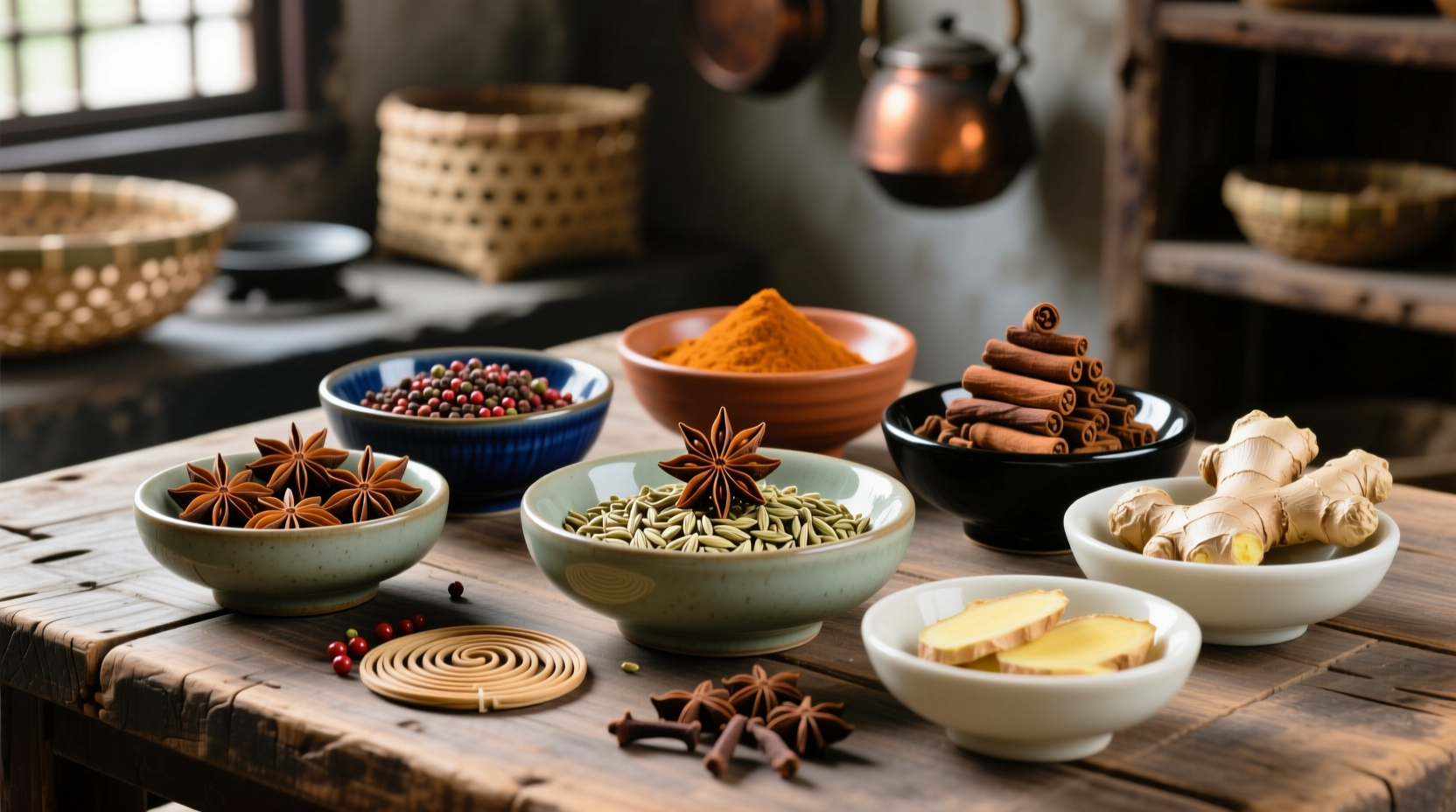Discover exactly what goes into this essential Chinese seasoning blend and how each component contributes to its distinctive flavor profile. Whether you're a home cook experimenting with Asian cuisine or a professional chef refining your techniques, understanding the precise composition of five spice powder will transform your cooking.
The Essential Components of Five Spice Powder
At its core, five spice powder combines five specific spices in varying proportions. While regional variations exist, the traditional blend maintains these foundational ingredients:
| Spice | Flavor Profile | Traditional Proportion | Philosophical Element |
|---|---|---|---|
| Star Anise | Sweet, licorice-like | 30% | Wood |
| Cloves | Warm, pungent | 20% | Fire |
| Chinese Cinnamon | Sweet, woody | 20% | Earth |
| Sichuan Peppercorns | Citrusy, numbing | 20% | Metal |
| Fennel Seeds | Mildly sweet, herbal | 10% | Water |
According to research from the Journal of Ethnic Foods, these proportions follow traditional Chinese culinary philosophy where each spice represents one of the five elements (wood, fire, earth, metal, water) and one of the five basic tastes (sour, bitter, sweet, pungent, salty). This balance creates a seasoning that complements rather than overwhelms dishes.
Historical Development Timeline
Five spice powder has evolved over centuries, adapting to changing culinary landscapes while maintaining its essential character:
- 206 BCE-220 CE (Han Dynasty): Early versions of spice blends emerge in Chinese cooking, though not yet standardized as "five spice"
- 618-907 CE (Tang Dynasty): Trade along the Silk Road introduces new spices to Chinese kitchens
- 1368-1644 CE (Ming Dynasty): Standardized five spice blend becomes common in southern China, particularly in Fujian and Guangdong provinces
- 19th Century: Chinese immigrants bring the blend to Southeast Asia and beyond, creating regional variations
- Mid-20th Century: Commercial production makes five spice powder widely available globally

Regional Variations Across Asia
While the traditional Chinese blend remains the standard, regional adaptations have developed unique characteristics. Understanding these differences helps you select the right version for your cooking needs:
| Region | Key Differences | Best Used For | Notable Absences |
|---|---|---|---|
| Mainland China | Standard proportions with emphasis on Sichuan peppercorns | Braising meats, especially pork and duck | Ginger, turmeric |
| Taiwan | Slightly sweeter with more cinnamon | Three-cup chicken, braised tofu | Less star anise |
| Vietnam | Includes additional black pepper, sometimes with licorice root | Pho broth, grilled meats | Reduced cloves |
| Singapore/Malaysia | Often includes additional ginger or turmeric | Char kway teow, satay marinades | Less fennel |
Food historians at the University of California, Davis note that these regional variations reflect local ingredient availability and cultural preferences. For instance, Vietnamese adaptations incorporate more black pepper to complement their cuisine's emphasis on fresh herbs and clear broths.
Practical Applications in Your Kitchen
Understanding what's in five spice powder allows you to use it more effectively. This versatile blend works best in specific culinary contexts:
Perfect Pairings
- Pork and duck: The warming spices complement rich meats (try rubbing on pork belly before roasting)
- Stir-fries: Add 1/4 teaspoon per serving for depth without overpowering
- Braised dishes: Essential for Chinese red cooking techniques
- Rub for grilled meats: Combine with honey and soy for a flavorful crust
When to Avoid Five Spice
Despite its versatility, five spice powder has limitations. Culinary experts at the Culinary Institute of America recommend avoiding it with:
- Fish and seafood (overpowers delicate flavors)
- Most vegetarian dishes (can clash with vegetable flavors)
- Desserts (except in very small amounts for spice cookies)
- Fresh salads (the strong flavors don't complement raw ingredients)
Creating Authentic Five Spice Powder at Home
Store-bought versions often contain fillers or inconsistent proportions. For the most authentic flavor, make your own using these professional chef techniques:
- Toast whole spices: Heat a dry skillet over medium-low heat and toast each spice separately until fragrant (star anise: 1 minute, cloves: 45 seconds, etc.)
- Cool completely: Allow spices to cool to room temperature before grinding
- Grind in small batches: Use a dedicated spice grinder for best results
- Store properly: Keep in an airtight container away from light and heat
Research from the Journal of Food Science shows that freshly ground five spice powder contains up to 40% more volatile flavor compounds than pre-ground versions. The study recommends using whole spices within 6 months of purchase for optimal flavor.
Common Substitutions and Alternatives
When you don't have five spice powder available, these substitutions can work in a pinch:
- Star anise substitute: 1/2 teaspoon anise seeds + 1/4 teaspoon fennel seeds
- Cloves substitute: Allspice (use half the amount)
- Chinese cinnamon substitute: Cassia bark (preferred) or Ceylon cinnamon
- Sichuan peppercorns substitute: Black pepper + lemon zest (not ideal but works)
- Complete blend substitute: 1/2 teaspoon each of cinnamon, allspice, and fennel seeds plus 1/4 teaspoon each of ground ginger and cloves
Remember that substitutions won't perfectly replicate the complex balance of authentic five spice powder. As Chef Liu Wei notes, "The magic happens in the precise interaction between all five components - changing even one element alters the entire flavor profile."
Storage and Shelf Life Guidelines
To maintain the vibrant flavor of your five spice powder:
- Store in an airtight container away from direct light
- Keep in a cool, dark place (not next to your stove!)
- Whole spices last 1-2 years; ground blend lasts 6-8 months
- Test freshness by rubbing a small amount between your fingers - if the aroma is weak, it's time to replace
Food safety experts at the USDA recommend labeling your spice containers with purchase dates to track freshness. Exposure to heat, light, and humidity significantly reduces the potency of spice blends.











 浙公网安备
33010002000092号
浙公网安备
33010002000092号 浙B2-20120091-4
浙B2-20120091-4